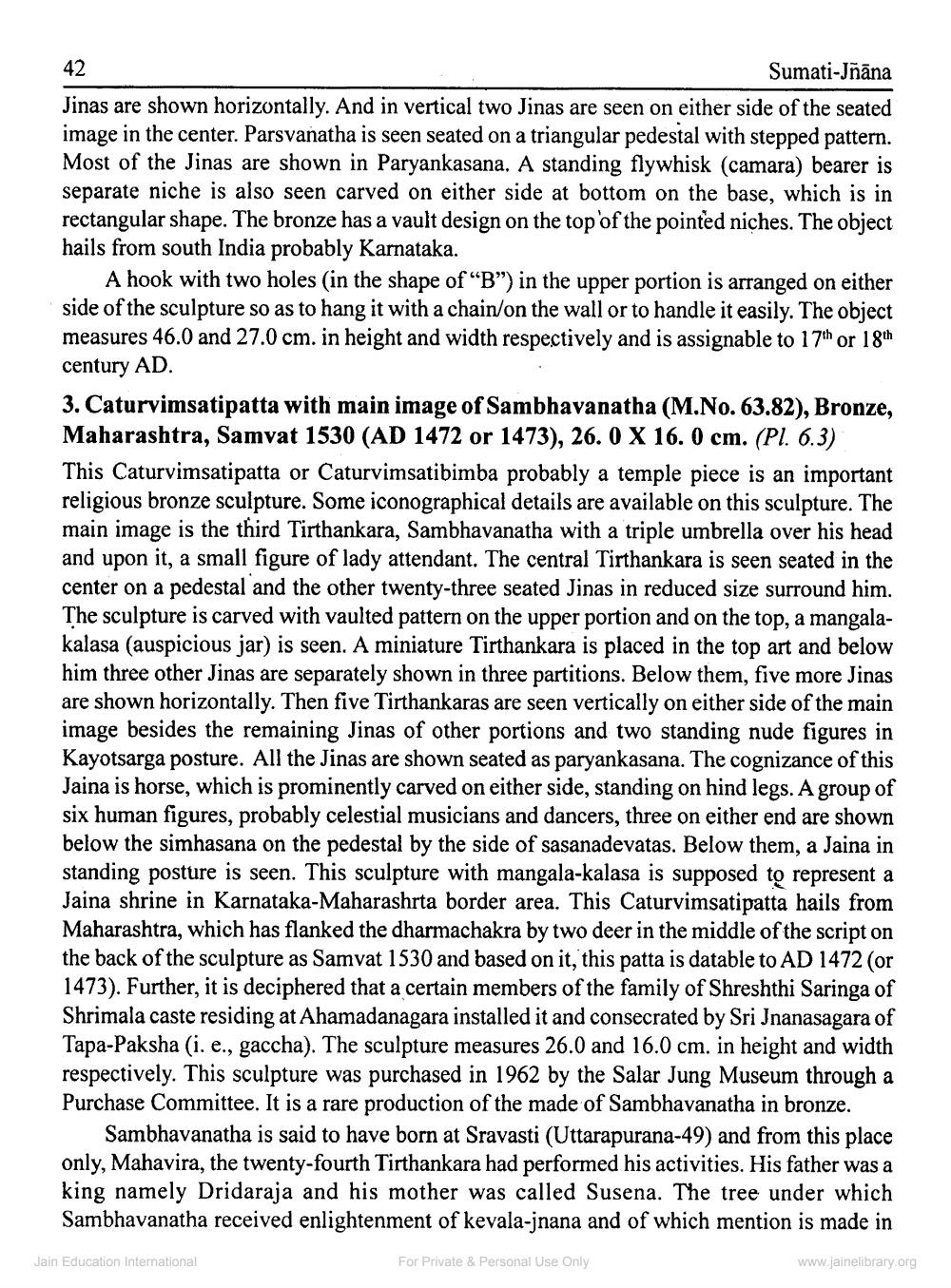________________
42
Sumati-Jñāna Jinas are shown horizontally. And in vertical two Jinas are seen on either side of the seated image in the center. Parsvanatha is seen seated on a triangular pedestal with stepped pattern. Most of the Jinas are shown in Paryankasana. A standing flywhisk (camara) bearer is separate niche is also seen carved on either side at bottom on the base, which is in rectangular shape. The bronze has a vault design on the top of the pointed niches. The object hails from south India probably Karnataka.
A hook with two holes in the shape of “B”) in the upper portion is arranged on either side of the sculpture so as to hang it with a chain on the wall or to handle it easily. The object measures 46.0 and 27.0 cm. in height and width respectively and is assignable to 17th or 18th century AD. 3. Caturvimsatipatta with main image of Sambhavanatha (M.No.63.82), Bronze, Maharashtra, Samvat 1530 (AD 1472 or 1473), 26. 0 X 16.0 cm. (Pl. 6.3) This Caturvimsatipatta or Caturvimsatibimba probably a temple piece is an important religious bronze sculpture. Some iconographical details are available on this sculpture. The main image is the third Tirthankara, Sambhavanatha with a triple umbrella over his head and upon it, a small figure of lady attendant. The central Tirthankara is seen seated in the center on a pedestal and the other twenty-three seated Jinas in reduced size surround him. The sculpture is carved with vaulted pattern on the upper portion and on the top, a mangala kalasa (auspicious jar) is seen. A miniature Tirthankara is placed in the top art and below him three other Jinas are separately shown in three partitions. Below them, five more Jinas are shown horizontally. Then five Tirthankaras are seen vertically on either side of the main image besides the remaining Jinas of other portions and two standing nude figures in Kayotsarga posture. All the Jinas are shown seated as paryankasana. The cognizance of this
s horse, which is prominently carved on either side, standing on hind legs. A group of six human figures, probably celestial musicians and dancers, three on either end are shown below the simhasana on the pedestal by the side of sasanadevatas. Below them, a Jaina in standing posture is seen. This sculpture with mangala-kalasa is supposed to represent a Jaina shrine in Karnataka-Maharashrta border area. This Caturvimsatipatta hails from Maharashtra, which has flanked the dharmachakra by two deer in the middle of the script on the back of the sculpture as Samvat 1530 and based on it, this patta is datable to AD 1472 (or 1473). Further, it is deciphered that a certain members of the family of Shreshthi Saringa of Shrimala caste residing at Ahamadanagara installed it and consecrated by Sri Jnanasagara of Tapa-Paksha (i. e., gaccha). The sculpture measures 26.0 and 16.0 cm. in height and width respectively. This sculpture was purchased in 1962 by the Salar Jung Museum through a Purchase Committee. It is a rare production of the made of Sambhavanatha in bronze.
Sambhavanatha is said to have born at Sravasti (Uttarapurana-49) and from this place only, Mahavira, the twenty-fourth Tirthankara had performed his activities. His father was a king namely Dridaraja and his mother was called Susena. The tree under which Sambhavanatha received enlightenment of kevala-jnana and of which mention is made in
Jain Education International
For Private & Personal Use Only
www.jainelibrary.org




